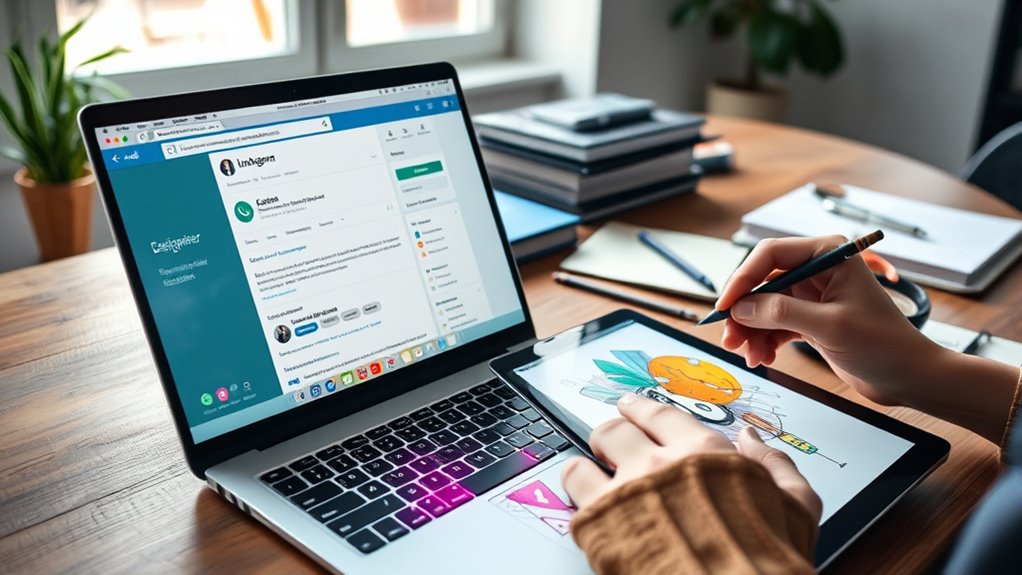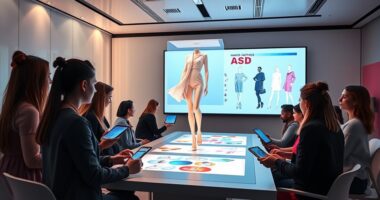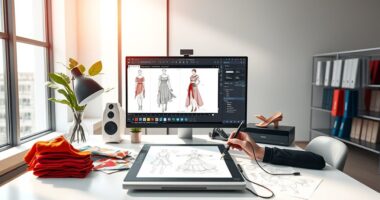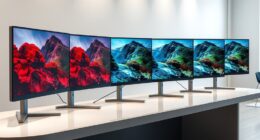When networking on LinkedIn as an aspiring designer, craft personalized messages that reference specific work from your portfolio and connect it to their projects. Keep the tone friendly, professional, and focused on adding value. Mention shared interests or mutual connections and avoid sounding overly formal. Follow up politely if you don’t get a response. Mastering these strategies can help turn simple connections into meaningful opportunities — explore further to see how to refine your approach.
Key Takeaways
- Personalize outreach messages by referencing specific portfolio pieces or shared interests to demonstrate genuine interest and research.
- Maintain a friendly, professional tone that highlights how your design skills can add value to the recipient’s projects.
- Keep messages concise, focusing on common goals, mutual connections, or industry events to foster authentic engagement.
- Follow up politely after one week if no response, reiterating your interest and referencing your initial message.
- Showcase your work effectively by linking relevant projects, reinforcing credibility and attracting potential collaborations.
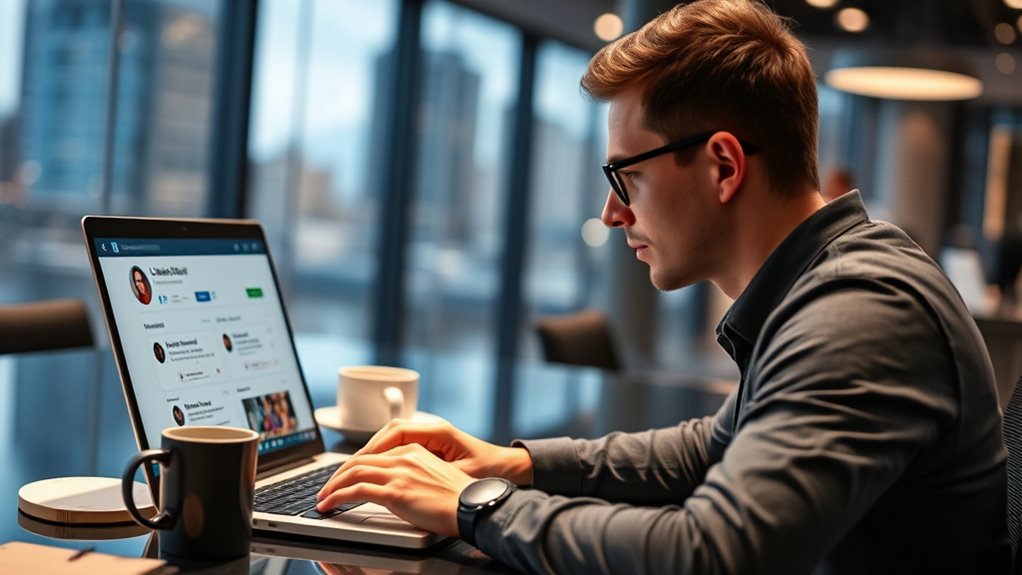
Have you ever wondered how to turn LinkedIn into a powerful networking tool? It’s more than just a digital resume; it’s a platform where you can showcase your skills, connect with industry professionals, and open doors to new opportunities. To do this effectively, you need to craft messaging that captures attention and builds genuine relationships. Your first step is understanding the importance of branding strategies. Think of your LinkedIn profile as your personal brand. Every message you send should reinforce who you are as a designer and what sets you apart. Use your messaging to highlight your unique style, creative approach, and the value you bring to potential collaborators or employers. This consistency helps establish a recognizable personal brand that sticks in people’s minds. Additionally, understanding the impact of project presentation on your profile can significantly boost your credibility and attract interest.
Transform your LinkedIn into a personal branding powerhouse by showcasing your unique style and building genuine connections.
Portfolio development is also vital. When reaching out, don’t just say, “Hi,” or ask for a job outright. Instead, reference specific pieces from your portfolio that relate to the recipient’s work or interests. For example, you might say, “I noticed your recent project on sustainable packaging, and I thought you’d appreciate my recent work on eco-friendly branding strategies.” This shows you’ve taken the time to research their background and that you’re genuinely interested in connecting over shared interests. Including a link to your portfolio or a specific project can make it easier for them to see your skills firsthand, reinforcing your credibility and professionalism.
Your messaging scripts should be clear, concise, and personable. Start with a friendly introduction that establishes common ground, such as mutual connections, shared interests, or industry events. Then, briefly mention how your skills or past work could add value to their projects or goals. For example, “I admire your innovative approach to digital branding, and I believe my experience developing branding strategies could contribute to your upcoming campaigns.” Keep the tone professional yet approachable, avoiding overly formal language that might create distance. Remember, people appreciate authenticity and enthusiasm.
When you craft your messages, always aim to provide something of value—whether that’s sharing insights, offering to collaborate, or simply asking for advice. This approach turns a cold outreach into a meaningful interaction. Be respectful of their time, and don’t expect immediate responses. Follow up politely if you don’t hear back after a week, reiterating your interest and referencing your initial message. Over time, these small, personalized interactions build trust and deepen your network. By applying these principles—strong branding strategies, thoughtful portfolio development, and genuine messaging—you’ll transform your LinkedIn connections into valuable opportunities for growth and collaboration.
Frequently Asked Questions
How Do I Personalize My Linkedin Connection Requests Effectively?
You want to personalize your LinkedIn connection requests effectively by using strong personalization strategies. Start by mentioning a shared interest, mutual connection, or recent post to show genuine engagement. Keep your message concise and respectful, following connection etiquette. Avoid generic messages, and instead, tailor each request to reflect why you’re reaching out. This approach builds trust and increases the likelihood of a positive response, making your network more meaningful and relevant.
What Are the Best Times to Send Linkedin Messages for Responses?
You wonder about the best times to send LinkedIn messages for responses. Generally, the most favorable engagement hours are weekday mornings between 8-10 AM and early afternoons around 1-3 PM. These are when most users are active, increasing your chances of receiving a reply. Pay attention to your target audience’s time zones and activity patterns, and experiment with different times to find your personal best posting times for higher engagement.
How Can I Follow up Without Seeming Pushy?
Imagine you’re catching up with an old friend; you don’t want to seem pushy, right? That’s where polite persistence and timing strategies come in. When you follow up on LinkedIn, wait a reasonable period, like a week, and keep your tone friendly and light. A simple message showing genuine interest, without pressure, helps you stay top of mind without seeming pushy. It’s all about respectful timing and thoughtful persistence.
What Should I Include in a Portfolio Link Shared via Linkedin?
When sharing your design portfolio link, make sure to include a clear, concise introduction highlighting your skills and experience. Showcase your best work with a project showcase that demonstrates your versatility and creativity. Keep the link easily accessible and organized, so viewers can quickly navigate your design portfolio. This approach helps you make a strong impression, showing your potential without overwhelming the recipient.
How Do I Handle Rejection or No Response Professionally?
Think of rejection handling as weathering a storm—you stay steady and resilient. When you don’t get a response, don’t take it personally; instead, use response strategies like a polite follow-up or asking for feedback. If rejected, thank them for their time and keep the door open. This approach shows professionalism and keeps your network alive, turning setbacks into stepping stones toward future opportunities.
Conclusion
By mastering these messaging scripts, you’ll open doors on LinkedIn like a key revealing new opportunities. Remember, every connection is a stepping stone across a river of possibilities. Keep your tone genuine and your intentions clear, and you’ll build a network that supports your creative journey. Stay persistent, and soon your LinkedIn network will be a thriving garden blooming with collaboration and inspiration, ready for you to harvest success.

